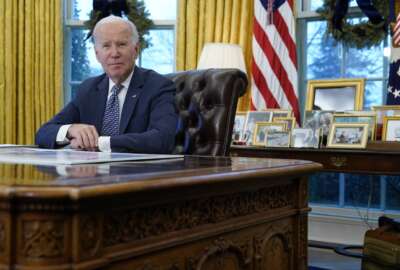
After pushback, NSF implements 4.6% average pay raise for all excepted service employees
National Science Foundation officials announced that all agency employees will receive a 4.6% pay raise for 2023, striking initial plans to implement a 1% raise for...
All National Science Foundation employees on the Administratively Determined (AD) pay scale will receive a 4.6% average pay raise for 2023.
Agency leadership announced the update in an email to staff, obtained by Federal News Network, after NSF officials previously made plans to implement a 1% average pay raise for employees in the fourth bracket of the AD scale. An NSF spokesperson said the initial plans were “prematurely” sent to staff.
Regardless of the decision on pay for AD employees, General Schedule employees at NSF received the 4.6% average pay raise, which President Joe Biden enacted in December.
There are 678 employees at NSF categorized as AD-4, 334 of which are at the top of the AD scale and would have been impacted by the now-revoked plan. Currently, AD-4 employees working in the D.C. area make between $160,889 and $198,690 annually, according to an NSF spokesperson. In 2021, AD-4 employees at NSF made between $148,933 and $190,947. AD-4 employees are program directors, mostly running science and technical programs. There are 868 GS employees at NSF, according to data from the Office of Personnel Management.
The agency’s plan to cap the pay raise for AD-4 employees, which Federal News Network reported Tuesday, was an effort by agency management to ensure the salaries of AD-4 employees did not exceed those of NSF career employees in the Senior Executive Service (SES).
Agencies can set wages for employees in excepted service pay scales, such as the AD scale, based on what they believe is necessary to effectively recruit and retain the workforce. In contrast, pay for General Schedule (GS) employees is set by a presidential administration, occasionally with input from Congress.
Some career GS federal employees experience pay compression once reaching the GS-14 or GS-15 levels. Salaries for GS employees cannot exceed pay rates for political appointees and others at level IV on the Executive Schedule, according to federal statute. Career SES employees are also subject to a pay cap.
NSF leadership said they will continue to consider alternatives to address pay differentiation issues between SES and AD-4 employees.
“As we look to address equity issues agency-wide, an important aspect is the pay differentiation between the AD, SES and GS pay scales, which must be addressed. To be clear, we will use a transparent process to develop a strategy to address this equity challenge,” NSF Director Sethuraman Panchanathan and Chief Operating Officer Karen Marrongelle said in the email to staff.
The initial plans to cap the pay raise quickly gained criticism from the American Federation of Government Employees, the federal union representing NSF workers. One alternative option to address the pay disparity would be to incorporate a pay cap for AD-4 employees over the course of several years, rather than instituting it all at once, AFGE said.
AD-4 employees additionally expressed anger and frustration with the prior announcement, calling it a “breach of trust” and a “betrayal,” and arguing that a pay cap could lead to challenges with recruitment and retention of science program directors at the agency.
“I don’t feel that NSF upper management fully appreciates their program directors,” one NSF employee wrote in an email to AFGE. “I can report that the level of disgruntlement and disappointment among my colleagues is high.”
NSF leaders said they will meet with SES, AD and GS staff in the coming weeks to hear all of their perspectives on the issue of pay disparities.
“Ensuring an equitable and supportive environment for everyone is our highest priority,” NSF officials said. “NSF leadership values all employees equally no matter what position, pay plan, rank or role they serve in. Our workforce is our most important asset, and we cannot accomplish our mission without you.”
Copyright © 2025 Federal News Network. All rights reserved. This website is not intended for users located within the European Economic Area.
Drew Friedman is a workforce, pay and benefits reporter for Federal News Network.
Follow @dfriedmanWFED





